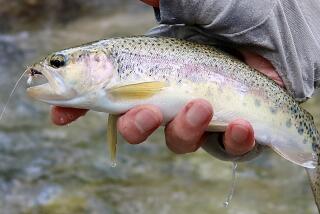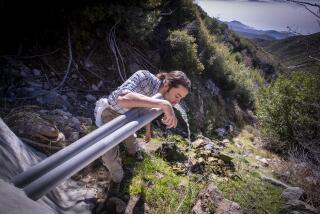Caravan Takes Trout to New Home : Sespe Creek: Thirty volunteers ferry thousands of fingerlings to a backcountry tributary.
Hundreds of hikers and horsemen have trekked into the Sespe wilderness above Fillmore hoping to pull a few trout from Sespe Creek. But this weekend, a few outdoor enthusiasts went against the flow by bringing fish to the creek.
In a scheme hatched by Santa Paula outdoorsman Dave Mitchell, a caravan of pack mules and horses carried thousands of fingerling rainbow trout into the backcountry to restock a tributary of Sespe Creek.
For most of the 30 volunteers, it was a mission of mercy for the drought-stricken wilderness they love.
“It’s the last place we have left,” Mitchell said of the Sespe wilderness, the vast undeveloped area that reaches deep into the Los Padres National Forest. “We need to take care of it.”
After seeing precious few fish on his last trek into the Sespe, Mitchell decided that the creek needed some help. First, he persuaded the U.S. Forest Service and the state Department of Fish and Game to grant permission for human intervention.
Then, he enlisted the aid of veteran Santa Paula horse-packers Mike Lambert and Charlie Hengehold, who organized a caravan of 40 horses and mules and a crew of enthusiastic volunteers.
The trip began at 7 a.m. Saturday when about 4,400 fingerling trout were loaded from the Fillmore Fish Hatchery into a chilled tank and trucked an hour to the beginning of the trail into the Sespe.
At the trail head, hatchery staff quickly scooped the fish into 10-gallon containers that resembled old-fashioned milk cans. Then the six containers, each holding 75 pounds of water and fish, were loaded onto three pack mules.
Speed was essential to the mission. The survival of the tiny trout depended on keeping the water cool and well-agitated--to maintain a sufficient level of oxygen, said Mauricio Cardena of the hatchery. Once water heats up, he said, oxygen dissipates.
As soon as the containers were secured to the animals’ pack saddles, Lambert mounted his horse and set off up the trail with the string of three mules behind. The lead horse’s brisk pace shaved about 30 minutes off the time that it usually takes to travel the often steep and narrow trail.
Within two hours, the pack mules arrived at their destination at Alder Creek. Three volunteers worked quickly to empty the containers into fast-flowing stretches that feed into Sespe Creek.
Some of the fish appeared temporarily stunned, while others swam into shallow water where they could be stranded. The handlers spent several minutes splashing the trout away from the shallows, and moving rocks in the stream to improve the flow. About 10% of the fish had died. But most seemed to adapt quickly to their new home in the wild.
The team chose Alder Creek because regulations prevent restocking Sespe Creek, a designated Wild Trout Stream, said Morgan Boucke, a Fish and Game wildlife biologist who assisted in the effort. She said regulations allow stocking tributaries with fish, but not the Sespe itself.
Hatchery manager Jim Adams said the five-year drought has interrupted Fish and Game’s normal two-year schedule of restocking fish in backcountry streams. At least a dozen years have passed since Alder Creek was stocked with fish, he said.
The expedition brought together a diverse group, ranging in age from Andrew Hengehold, nearly 6 years old and already an experienced “packer,” to citrus rancher Bob Proctor, 69. Participants included a beekeeper, the owner of a feed store, an oil field worker and the proprietor of a bookstore.
But all shared a deep appreciation of the Sespe. As they sat around a campfire Saturday night, they debated the best way to preserve and enjoy the wilderness.
For John Nichols, a volunteer from Santa Paula, stocking the stream was only one way the expedition would benefit the backcountry. “It’s a way of teaching each other how to preserve and protect the wilderness.”
More to Read
Sign up for The Wild
We’ll help you find the best places to hike, bike and run, as well as the perfect silent spots for meditation and yoga.
You may occasionally receive promotional content from the Los Angeles Times.






